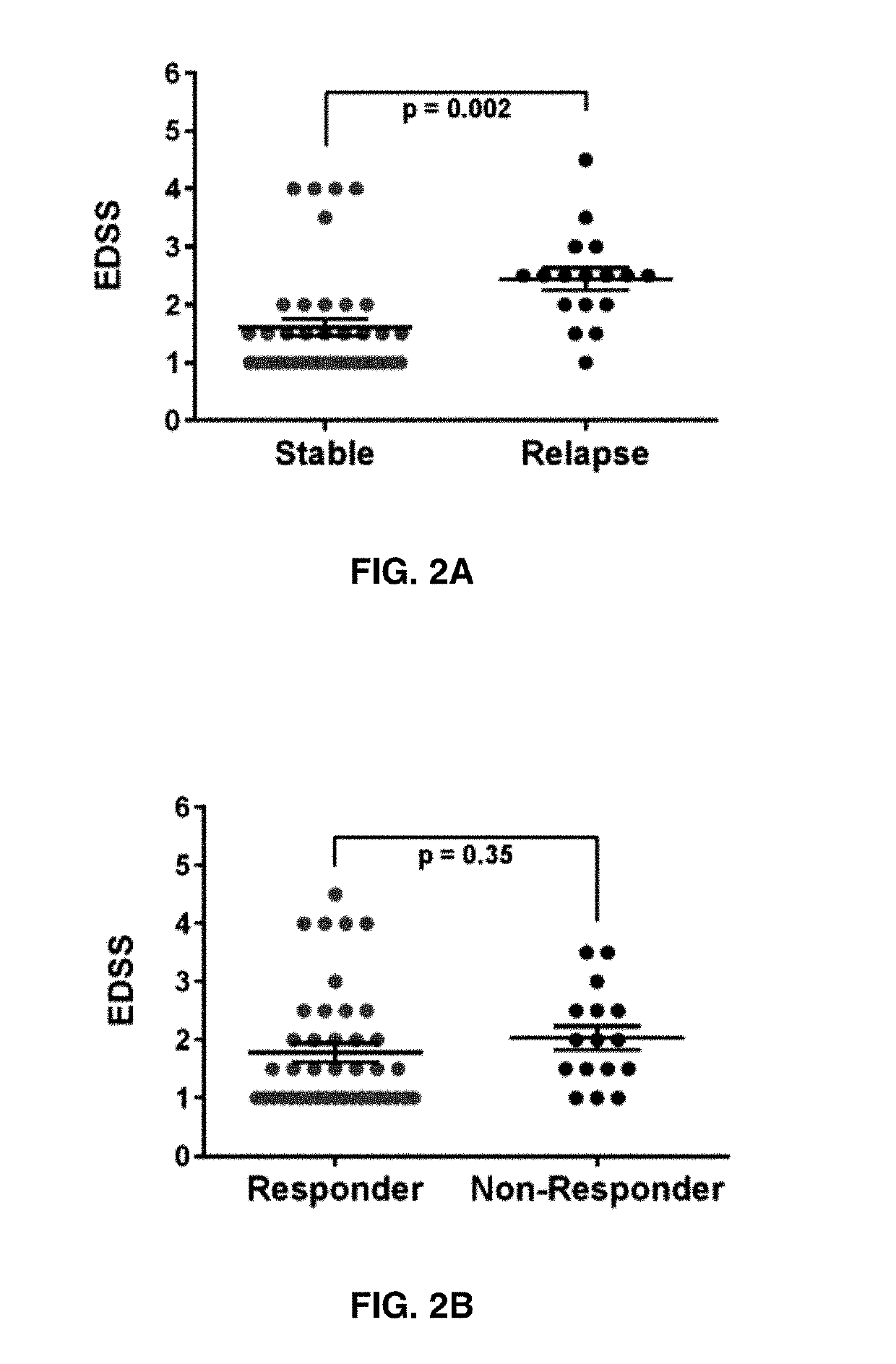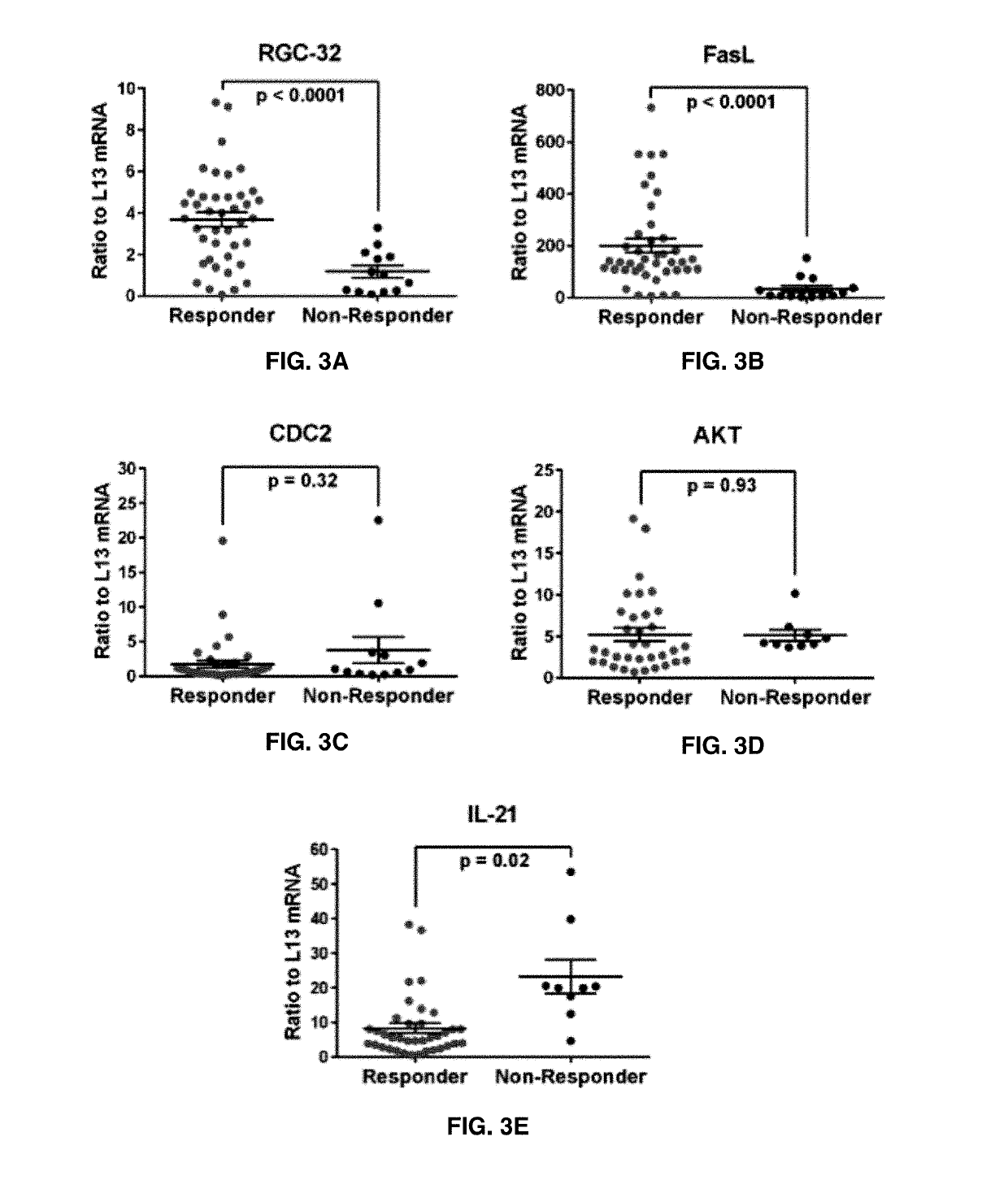Diagnosis and prognosis of multiple sclerosis
a multiple sclerosis and diagnosis technology, applied in the field of diagnosis and treatment neurology, can solve the problems of poor correlation between mri results and disease activity, complicated cyclin dependent pathway, and long term predictive value, and achieve the effect of accurately detecting response and accurately detecting relaps
- Summary
- Abstract
- Description
- Claims
- Application Information
AI Technical Summary
Benefits of technology
Problems solved by technology
Method used
Image
Examples
example 1
Materials and Methods
Patients and Controls
[0053]A total of 15 patients with RRMS were enrolled. The patients were recruited from the University of Maryland Multiple Sclerosis Center. The mean age was 40 (range, 22-60), and consisted of 60% females (n=9) and 40% males (n=6). The criteria for inclusion of multiple sclerosis patients in the study were: (i) age 18 to 65 years; (ii) fulfillment of the McDonald criteria for definite multiple sclerosis (13-14); (iii) relapsing-remitting course; (iv) having newly diagnosed multiple sclerosis, or multiple sclerosis not treated with currently used immunomodulatory drugs (interferon-β or glatiramer acetate) for 3 months prior to study entry; (v) no exacerbations in the 4 weeks before the study; (vi) no i.v. or p.o. steroids for 4 weeks prior to study enrollment; (vii) no treatment with Tysabri, Gilenya, mitoxantrone, cyclophosphamide, or any investigational drug during the past year; and (viii) a disability score of 0-5.5, as defined by the ex...
example 2
Expression of RGC-32, FasL, CDC2, AKT, and IL-21 mRNA in Acute MS Relapse
[0059]The expression of RGC-32 mRNA in unstimulated PBMCs in relation to disease activity was first examined. FasL and CDC2 mRNA expression were also investigated. In addition, IL-21 and AKT mRNA expression were investigated. Multiple sclerosis patient PBMC samples were categorized into those from stable periods in which no clinical activity was present and those from periods of relapse, in which clinical activity was present and had been detected by a neurologist. Target gene mRNA expression was measured in patients' PBMCs using real-time qRT-PCR and expressed as a ratio to L13. Statistically significant lower levels of RGC-32 mRNA were found in multiple sclerosis patients with relapses compared to those who were clinically stable (p<0.0001) (FIG. 1A). Patients with relapses also exhibited significantly lower levels of FasL mRNA compared to stable multiple sclerosis patients (p<0.0001) (FIG. 1B). Levels of CDC...
example 3
Expression of RGC-32, FasL, CDC2, AKT, and IL-21 mRNA in Responders vs. Non-Responders to GA Treatment
[0060]Since glatiramer acetate is an effective treatment for RRMS, the relationship between RGC-32, FasL, CDC2, AKT, and IL-21 mRNA expression and responsiveness to treatment over time was examined. Responders to glatiramer acetate treatment were defined as patients who exhibited 0 or no more than 1 relapse event during the 2 year span following the initiation of glatiramer acetate whereas non-responders exhibited 2 or more relapse events. Overall, responders to glatiramer acetate treatment showed significantly higher levels of RGC-32 (p<0.0001) and FasL (p<0.0001) (FIGS. 3A-3B). No significant change was observed in CDC2 or AKT expression between responders and non-responders (FIGS. 3C-3D). IL-21 mRNA levels were lower in responders to glatiramer acetate treatment compared to non-responders (p=0.02) (FIG. 3E).
[0061]Over time, responders to glatiramer acetate showed persistently hig...
PUM
| Property | Measurement | Unit |
|---|---|---|
| Magnetic Resonance Imaging | aaaaa | aaaaa |
| MRI | aaaaa | aaaaa |
| resistance | aaaaa | aaaaa |
Abstract
Description
Claims
Application Information
 Login to View More
Login to View More - R&D
- Intellectual Property
- Life Sciences
- Materials
- Tech Scout
- Unparalleled Data Quality
- Higher Quality Content
- 60% Fewer Hallucinations
Browse by: Latest US Patents, China's latest patents, Technical Efficacy Thesaurus, Application Domain, Technology Topic, Popular Technical Reports.
© 2025 PatSnap. All rights reserved.Legal|Privacy policy|Modern Slavery Act Transparency Statement|Sitemap|About US| Contact US: help@patsnap.com



